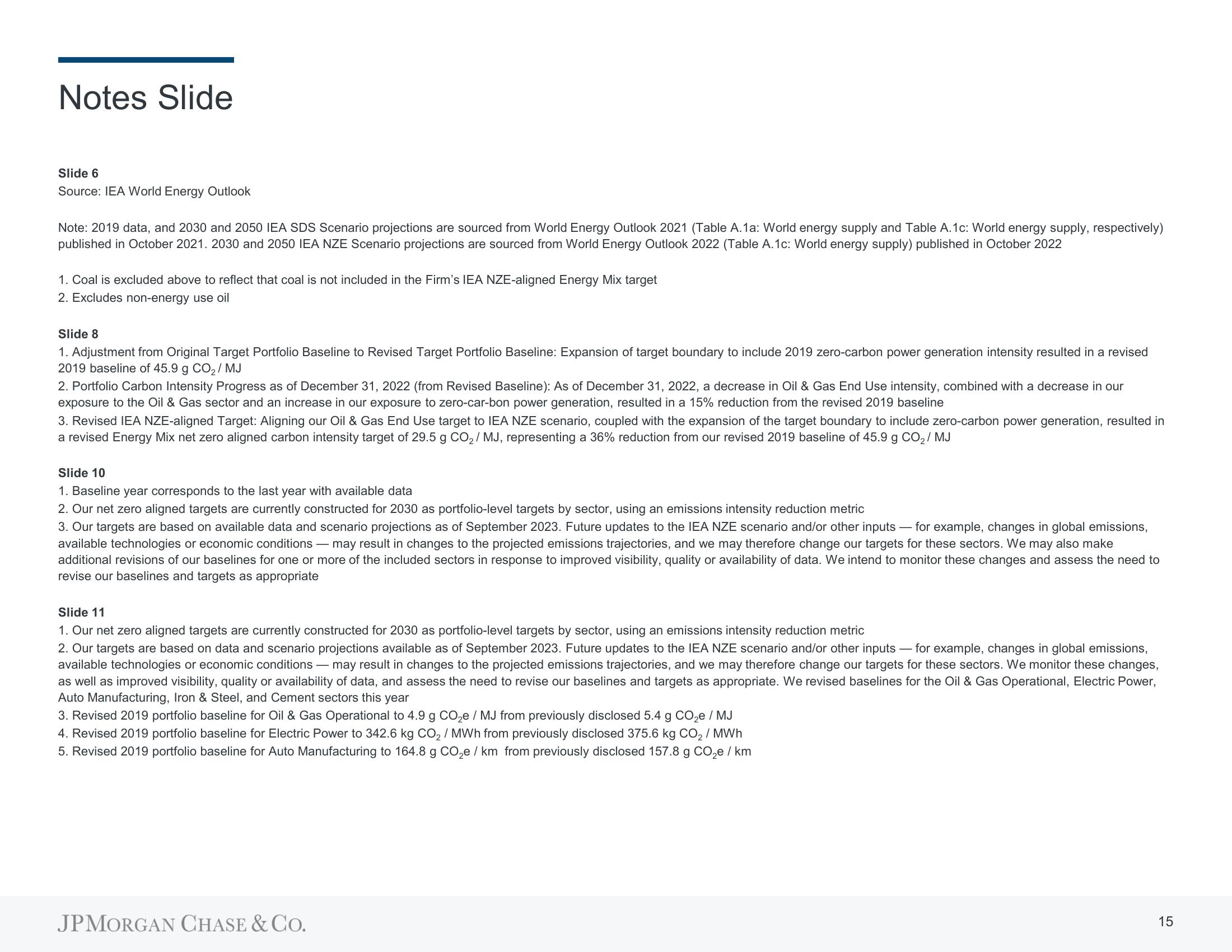J.P.Morgan ESG Presentation Deck
Notes Slide
Slide 6
Source: IEA World Energy Outlook
Note: 2019 data, and 2030 and 2050 IEA SDS Scenario projections are sourced from World Energy Outlook 2021 (Table A.1a: World energy supply and Table A.1c: World energy supply, respectively)
published in October 2021. 2030 and 2050 IEA NZE Scenario projections are sourced from World Energy Outlook 2022 (Table A.1c: World energy supply) published in October 2022
1. Coal is excluded above to reflect that coal is not included in the Firm's IEA NZE-aligned Energy Mix target
2. Excludes non-energy use oil
Slide 8
1. Adjustment from Original Target Portfolio Baseline to Revised Target Portfolio Baseline: Expansion of target boundary to include 2019 zero-carbon power generation intensity resulted in a revised
2019 baseline of 45.9 g CO₂/ MJ
2. Portfolio Carbon Intensity Progress as of December 31, 2022 (from Revised Baseline): As of December 31, 2022, a decrease in Oil & Gas End Use intensity, combined with a decrease in our
exposure to the Oil & Gas sector and an increase in our exposure to zero-car-bon power generation, resulted in a 15% reduction from the revised 2019 baseline
3. Revised IEA NZE-aligned Target: Aligning our Oil & Gas End Use target to IEA NZE scenario, coupled with the expansion of the target boundary to include zero-carbon power generation, resulted in
a revised Energy Mix net zero aligned carbon intensity target of 29.5 g CO₂/ MJ, representing a 36% reduction from our revised 2019 baseline of 45.9 g CO₂/MJ
Slide 10
1. Baseline year corresponds to the last year with available data
2. Our net zero aligned targets are currently constructed for 2030 as portfolio-level targets by sector, using an emissions intensity reduction metric
3. Our targets are based on available data and scenario projections as of September 2023. Future updates to the IEA NZE scenario and/or other inputs - for example, changes in global emissions,
available technologies or economic conditions - may result in changes to the projected emissions trajectories, and we may therefore change our targets for these sectors. We may also make
additional revisions of our baselines for one or more of the included sectors in response to improved visibility, quality or availability of data. We intend to monitor these changes and assess the need to
revise our baselines and targets as appropriate
Slide 11
1. Our net zero aligned targets are currently constructed for 2030 as portfolio-level targets by sector, using an emissions intensity reduction metric
2. Our targets are based on data and scenario projections available as of September 2023. Future updates to the IEA NZE scenario and/or other inputs for example, changes in global emissions,
available technologies or economic conditions may result in changes to the projected emissions trajectories, and we may therefore change our targets for these sectors. We monitor these changes,
as well as improved visibility, quality or availability of data, and assess the need to revise our baselines and targets as appropriate. We revised baselines for the Oil & Gas Operational, Electric Power,
Auto Manufacturing, Iron & Steel, and Cement sectors this year
3. Revised 2019 portfolio baseline for Oil & Gas Operational to 4.9 g CO₂e / MJ from previously disclosed 5.4 g CO₂e / MJ
4. Revised 2019 portfolio baseline for Electric Power to 342.6 kg CO₂/MWh from previously disclosed 375.6 kg CO₂/MWh
5. Revised 2019 portfolio baseline for Auto Manufacturing to 164.8 g CO₂e / km from previously disclosed 157.8 g CO₂e / km
JPMORGAN CHASE & CO.
15View entire presentation